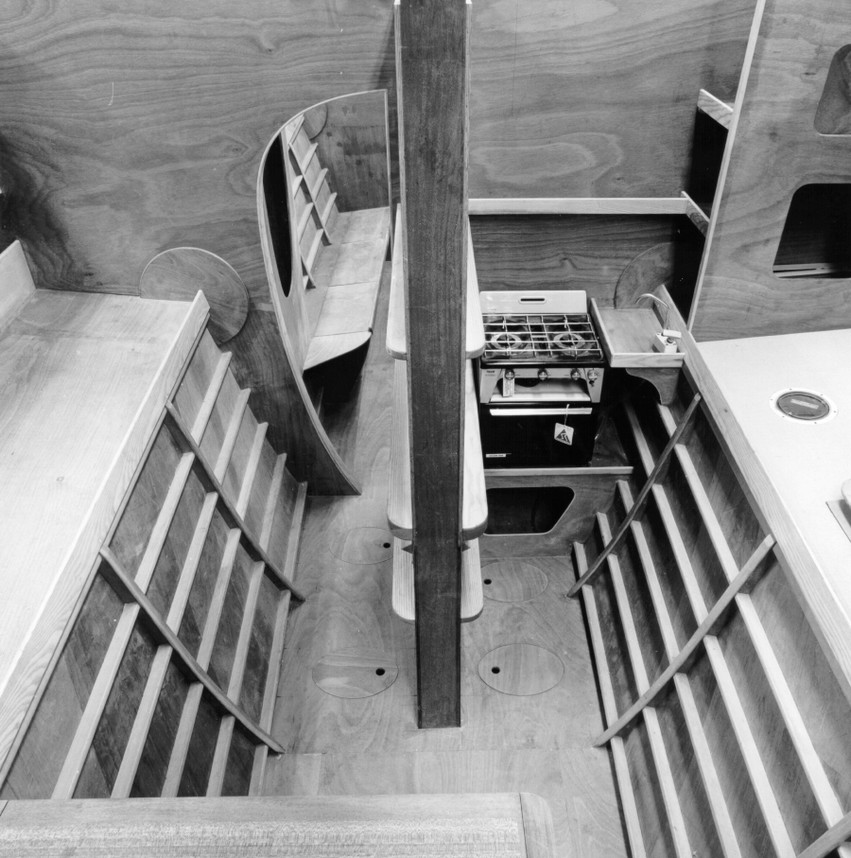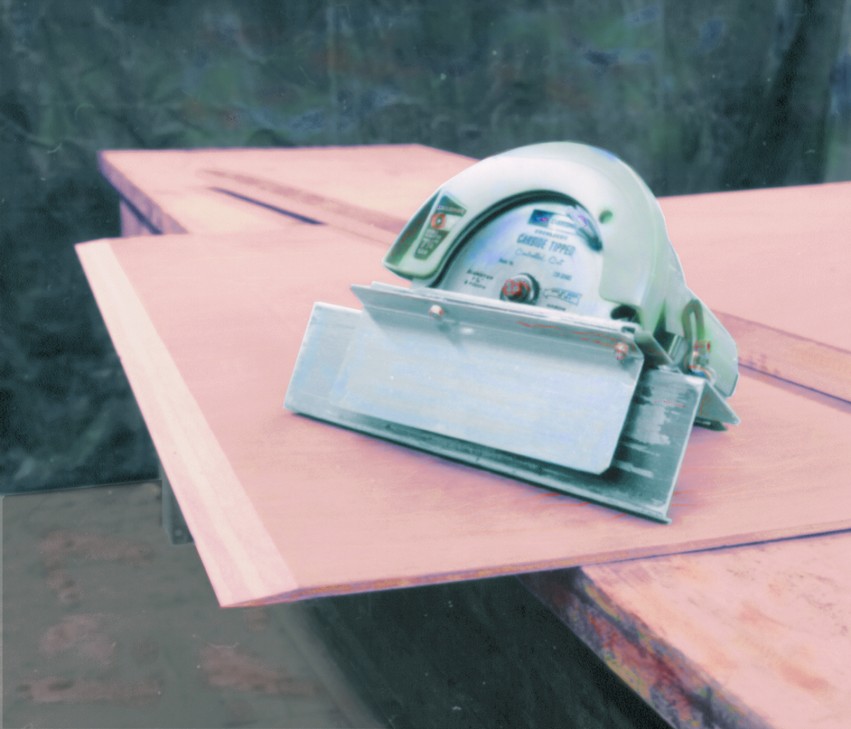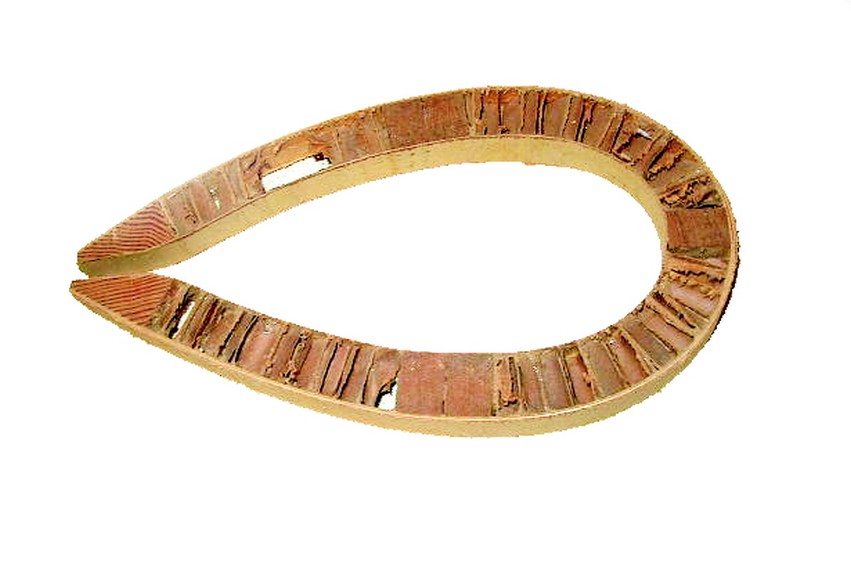
by Captain James R. Watson
Above: Marine-grade plywood basics include knowing how to select marine-grade plywood for flexibility vs. stiffness. This wing mast required plywood with some flexibility.
Since so many projects in Epoxyworks incorporate plywood, we felt it might be valuable to discuss briefly the types of marine-grade plywood and some construction methods best suited to it. It’s easy to understand why people like plywood and choose it for so many projects: it is readily available, comes in convenient sheets (typically 4’×8′), is pretty light for its stiffness and strength (1/8″ plywood weighs about 11 lb per 32 sq ft panel), and is a bargain when compared to the price of many composite panels.
However, plywood also has its weak points. There are limits regarding shape development because plywood can be compounded (bent in two directions at once) very little. In addition, plywood contains end grain on all its edges, which makes it susceptible to moisture migration and damage. So while we’ve had good success in a diversity of projects using plywood, it’s important to consider these guidelines.
Understand plywood grades
All plywood is graded based on the quality of the veneers and the size and number of permissible voids and patches. Grades A-C are the most common. To be suitable for marine construction, panels must be made with waterproof glue and marked as exterior plywood (EXT) or marine plywood.
As a general rule for boat projects, use marine-grade plywood because the wood used to make it is of higher quality with smaller voids and fewer patches. Inner veneers are also of higher quality, grade B or better. Marine plywood is, therefore, more stable, has less potential for checking, and the overall strength and stiffness are better than exterior plywood. When you consider the overall cost of a project, the price for marine-grade plywood is well worth it. While AC exterior plywood could be used on “low cost” boats, filling all the knots and voids may cost more in time and materials than if you had bought better grade plywood.
Aircraft-grade plywood is also very high quality and might be appropriate in specialized applications, such as a cored panel wing mast. Some builders have used door skins (3mm thick) when making a laminate of multiple layers, but you need to make sure they are glued with exterior grade glue and are of adequate quality. You should not use plywood underlayment for boat building because of its poor quality.
U.S. marine grade plywood must meet U.S. Products Standard PS 1-74 (applies only to softwood plywood).
Species: Douglas fir No 1 or western larch. Glue: waterproof. Face and back veneers A-A, A-B, B-B smooth cut and free of knots, pitch pockets and open splits and other open defects. Inner plies B or better. Repairs: no more than 9 repairs allowed on A faces in a 4×8 sheet.
Marine grade for tropical hardwoods must meet British Standard Specification BS 1088.
Species: untreated tropical hardwood veneers with suitable level of resistance to fungal attack. Glue: waterproof glue. Face veneers free of knots and other than solid pin knots no more than 6 in any 1 square foot area. Core veneers shall be the same as those for face veneers. No gaps in faces. In core, not more than one gap no wider than .5mm. Face veneers if three-ply construction shall not be thinner than 1/8” of the total thickness.Aircraft grade plywood meets all specifications of MIL-P-6070, which calls for shear testing after immersion in boiling water for three hours. It is made of imported African mahogany or American birch veneer laminated in a hot press to a hardwood core of poplar or basswood with waterproof glue.
Check the plies
Plywood typically comes in an odd number of plies in order to achieve balanced construction. The number of veneers on each side of the core layer must be equal in number (and thickness) or the panel may warp. The plies should be parallel to one another with alternating layers set at 90° or warping can occur. When you buy plywood, lay the sheet down on the ground. If it’s curled or twisted and doesn’t lie flat, don’t buy it. Select plywood where the total thickness of the two outer plies equals the thickness of the core. Avoid ‘cigar box’ stock where a thick core is sheathed with thin face veneers.
Most plywood under 1/4″ (6mm) is three-ply construction. One quarter-inch plywood and thicker is available in 5 or more plies. More plies are better because the panel is more dimensionally stable, less likely to warp, and stiffer than three-ply.
Know the wood species
Most marine-grade plywood is made from tropical hardwoods, like African mahogany, Sapele, utile, and okoume. Some wood species are more durable than others. Coating surfaces (especially exposed end grain) with epoxy greatly protects less durable woods from the harmful effects of moisture. While okoume is considered a non-durable species, we have had good long-term results with it. Much of this is the result of thorough coating with WEST SYSTEM® epoxy and careful maintenance of the finished boat, including ventilation and prompt repairs.
The biggest challenge with Douglas fir plywood is the propensity of its outer (face) veneer to check, that is, split along the grain. This is especially true when the outer surface forms a curve perpendicular to the face grain. Covering fir plywood with 6 oz fiberglass fabric is mandatory to contain the checking.
Limitations of pressure-treated plywood
Many people ask about the value of pressure-treated plywood. Often, pressure-treated plywood is heavily warped. This is primarily the result of the high temperature and rapid moisture take up during processing. Some plywood delaminates during the process. In addition, some pressure treating methods incorporate water-repellant materials. These materials can easily jeopardize bonding so you won’t be able to glue or paint the plywood successfully. Generally speaking, pressure-treated plywood may be acceptable for house projects but not for boats.
Select the right plywood for the project
With the many types of plywood available, it is important to choose and combine the types and thicknesses of plywood best suited to your project. For the kind of projects typically described in Epoxyworks, strength, durability, and weight are primary considerations. So we usually choose somewhat specialized plywood to meet the particular requirements of the project. For example, on a wing mast I built twenty years ago, I was after lightweight and flexibility. So, I selected plywood that would allow me to bend the laminate to a tight radius foil section: aircraft-grade 1/16″ birch on the mast’s exterior, and 1/64″ (3 ply) on the interior, with a honeycomb core.
On a current project, I’ve chosen a 9 mm teak-faced plywood to replace the live well and wet locker hatches on my Mako Angler. I wanted the teak finish and flat, hinged panels. So I chose a plywood with a teak face, stiffness, and dimensional stability. The point is to select carefully the best plywood for your project.

Building your own plywood
Some folks opt to build their own plywood by laying up multiple layers of sliced or peeled veneer. You need a suitable flat surface and a method of applying pressure until the adhesive that joins the layers has cured. Building your own plywood rarely saves money and the panels are often heavy. However, you can tailor your choice of a face veneer and it is possible to make some really beautiful panels. You also can make the panels whatever size you want. When you laminate a hull, as in cold-molded construction, you are actually making plywood to a specific shape, that of a boat hull (see Laminated construction gives lasting value).
Joining plywood panels
You can join plywood panels in a number of ways if you need sizes greater than standard ones. Scarf joints are the best approach for strength and weight. (If you order 16′ long panels, offered by some plywood suppliers, the panels are simply scarfed together, but you will pay a premium both for the material and the shipping.) Gougeon Brothers, Inc. does offer a custom attachment (875 Scarffer™) that fits onto a circular saw. This tool makes scarfing plywood panels of 3/8″ thickness or less quick and accurate. You can also fashion scarfs with a plane and/or grinder. The rule is to create a bevel 8 times the thickness of the plywood. Panels can also be joined with butt blocks, but this has the potential for exposing end grain at the butt. We like to dish out the butted area similar to a scarf and bond in fiberglass cloth.

See Joining Plywood for more on this topic.
Construction methods with plywood
Plywood is ideal for several construction methods. The most common is “stitch and glue” construction where panels are cut to a designed shape and temporarily joined with wire or plastic ties. Then you apply epoxy fillets and fiberglass tape to permanently join the structure in a rigid shape. Plywood has also been used successfully to build lightweight lapstrake boats. Master boatbuilder Tom Hill described this in his book, Ultralight Boatbuilding.
Probably the most extreme shapes can be gotten via “tortured,” also known as developed plywood construction, where the plywood is actually compounded. This construction method is limited to thin plywood and hulls with modest shapes, most typically multihull craft. Designing your own plywood boat used to be very challenging because if you introduced excessive compounding, you could have trouble laying out the plywood to the shape. With stitch and glue construction, it is extremely difficult to predict panel shapes. Now, however, some excellent software is available so you can get accurate offsets for the true shapes of panels.





